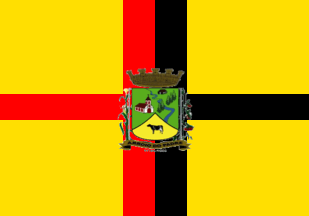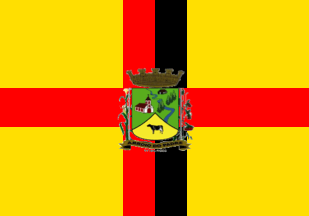 image by Ivan Sache,
11 July 2020
image by Ivan Sache,
11 July 2020 
Last modified: 2020-07-12 by ian macdonald
Keywords: rio grande do sul | arroio do padre |
Links: FOTW homepage |
search |
disclaimer and copyright |
write us |
mirrors
 image by Ivan Sache,
11 July 2020
image by Ivan Sache,
11 July 2020
The municipality of Arroio de Padre (2,895 inhabitants in 2016; 1é,432 ha) is
located 270 km south-west of Porto Alegre. Arroio de Padre is one of the four
Brazilian municipalities totally enclaved within an other municipality, here
Pelotas.
Arroio de Padre is the Brazilian municipality with the highest rate
of Christians, most of them (85%) being traditionalist Lutherians.
Arroio
do Padre was established in 1868 by Guilherme Bauer and Augusto Gerber, two
German colonists from Pelotas. Once part of the district of Santa Silvana,
Pelotas' old 6th district, Arroio de Padre was elevated to the 10th district of
Pelotas in 1967.
The municipality of Arroio de Padre was established on 17
April 1996 and inaugurated on 1 January 2001.
The origin of the name of
the municipality is disputed.
Some say that a Christian father ("padre")
established a community near a stream ("arroio"). Other say that "padre" refers
to an itinerant father who visited the area to celebrate marriages and baptism.
Yet another theory claims that the father fell down into the stream after a big
rain event. The latter version was reported in 2001 by Renilda Vahl Bohrer to
Jacob Parmagnani.
Other scholars believe that "padre" refers to Father
Francisco Xavier Prates, first manager of the Old Hemp Royal Mill, which was
established in 1783 in Canguçu and transferred to São Leopoldo on 1789. The
father was the brother of Paulo Xavier Rodrigues Prates, owner of a domain in
Canguçu and of the Factory island in Pelotas. The Prates family settled in the
region after the return of the town of Rio Grande under Portuguese sovereignty.
Father Prates was a relative of Manuel Marques de Souza, who expelled the
Spaniards from Rio Grande on 1 April 1776. This hypothesis is backed up by a map
elaborated in the beginning of the 20th century by Alberto Coelho da Cunha,
public servant in Pelotas. Some say, however, that Father Prates died in 1784
and never lived in Arroio de Padre.
Another possible "padre" is Father Pedro
Pereira Fernandes de Mesquita, aka the Doctor Father (1729-1813). Graduated at
the University of Coimbra, the father was ordained priest, maybe in 1754, and
served as a chaplain in his birth town of Colônia de Sacramento (now Colonia,
Uruguay). Sent to Buenos Aires after the conquest of the town by the Spaniards,
he returned to São Pedro (Rio Grande) in 1783. He owned domains in the region of
Pelotas.
http://povoadoresdepelotas.blogspot.com/2015/01/arroio-do-padre.html -
Pelotas blog, 12 January 2015
Ivan Sache, 11 July 2020
A deep yellow field with a narrow horizontal stripe in the
centre, black on the left, red on the right, and a red-black vertical stripe in
the centre; and in the centre the municipal arms.
Photos:
https://www.facebook.com/636720336464414
https://www.facebook.com/636720336464414
https://www.facebook.com/636720336464414
 image by Ivan Sache,
11 July 2020
image by Ivan Sache,
11 July 2020
The flag is also used, seemingly in less official
contexts, with a broader, fully red, horizontal stripe bands.
Photos:
https://www.facebook.com/636720336464414
https://www.facebook.com/636720336464414
The coat of arms, designed by Vera Schiller, is made of a Latin shield
featuring the stream ("arroio") for which the municipality was named, a house
representing the first settlers, trees representing the regional vegetation, a
church representing the Christian faith, a milk cow representing cattle-breeding
as a main source of income, and plants of maize and tomato representing
agriculture.
http://povoadoresdepelotas.blogspot.com/2015/01/arroio-do-padre.html -
Pelotas blog, 12 January 2015
Ivan Sache, 11 July 2020